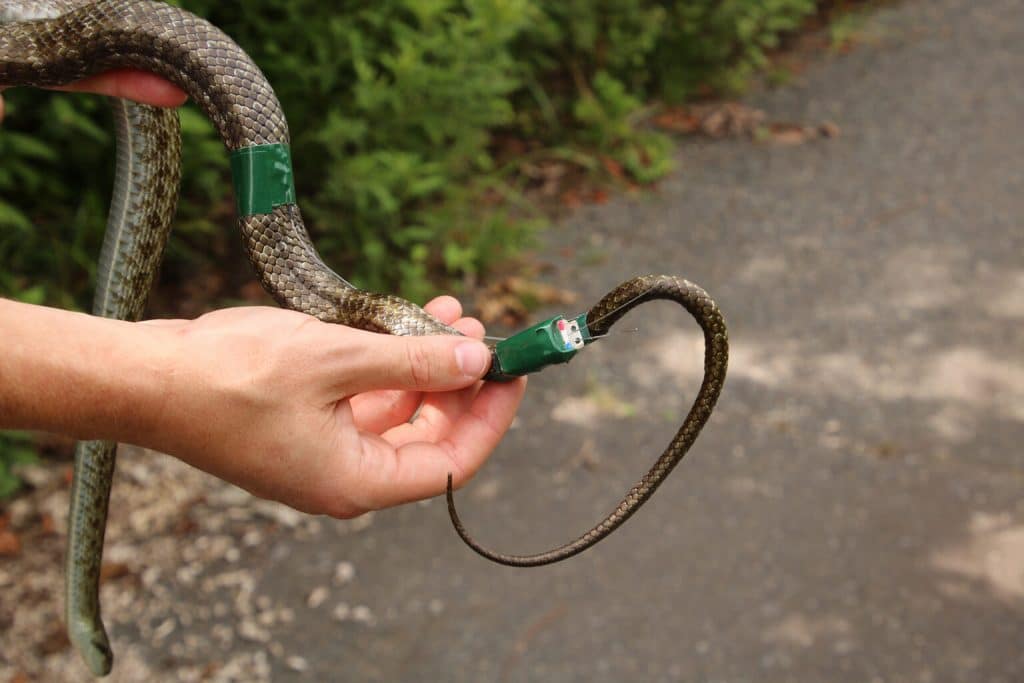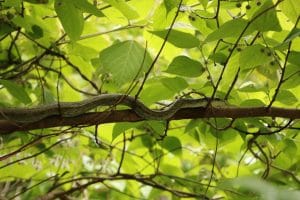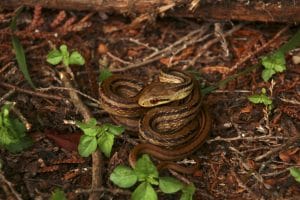Radioactive snakes may monitor Fukushima fallout
By Susan D’Agostino | August 17, 2021

When a massive earthquake followed by a tsunami hit Japan a decade ago, the Fukushima Daiichi Nuclear Power Plant experienced a catastrophic meltdown. Humans fled a wide area around the plant that today is known as the Fukushima Exclusion Zone, while animals and plants remained. Now, scientists have enlisted the help of snakes in the zone to make sense of the disaster’s impact on the environment. Their findings, reported in an Ichthyology and Herpetology paper, indicate that Fukushima’s native rat snakes, like canaries in a coal mine, may act as living monitors of radiation levels in the region.
“Because snakes don’t move that much, and they spend their time in one particular local area, the level of radiation and contaminants in the environment is reflected by the level of contaminants in the snake itself,” Hannah Gerke, a lead author on the study, said.
Animals, plants, or other life forms whose health provides insight into environmental health are known as bioindicators. For example, frogs, with their permeable skin and limited abilities to detoxify, are bioindicators of environmental pollution. And lichens, which have no roots and rely on nutrients from the atmosphere, are bioindicators of atmospheric pollution. Gerke’s recent study suggests that rat snakes may be useful bioindicators of radioactive contamination in nuclear disaster zones. But that does not necessarily mean that Fukushima’s environment or its snakes are languishing.
“Everybody expects Fukushima to be a barren wasteland full of mutated animals. In real life, it is quite beautiful,” Gerke said. “I was there in summer when everything was lush and green. There is wildlife everywhere—just a surprising lack of people.”

The scientists’ findings reinforced their 2020 study that found a high correlation between levels of radiocesium—a radioactive isotope of cesium—in the snakes and levels of radiation in their environment.
Why snakes and not, for example, birds? Not every animal in Fukushima’s exclusion zone is suited to the “work” of a bioindicator. That’s because the radiocesium that spewed from the nuclear disaster did not blanket the region evenly. For example, birds that travel far are exposed to contaminants all over the zone, which leaves them unable to provide insight into degrees of contamination in the zone’s smaller “neighborhoods.” But rat snakes have relatively small home ranges; they travel an average of 65 meters (approximately 213 feet) each day, according to the study. And they are susceptible to accumulating radionuclides—unstable atoms with excess nuclear energy—from disasters such as the one that took place in Fukushima. A rat snake that makes its home in a small but heavily contaminated area will tell a different story than a rat snake lives in a less contaminated locale.
In the decade since the nuclear disaster, most of the contaminants have settled in the soil. This means that animals such as birds that spend much of their time in trees have limited insight to offer about contaminants on the ground. But snakes, whose long bodies slither in and burrow under the soil, can help determine degrees of contamination.
Also, snakes live long, which means that the data they gather provides information about environmental contaminants over time.
How did scientists enlist the help of the snakes? The rugged Abukuma Highlands are situated approximately 15 miles northwest of the Fukushima Daiichi Nuclear Power Plant. This verdant terrain of hills and valleys is peppered with abandoned villages and farms—and, for a few recent months, scientists in search of snakes.
“Driving around these small curvy mountain roads, we watched for snakes crossing the road,” Gerke said, noting that snakes are active when the weather warms up. “Whenever we found one, we jumped out, caught it, and took it back to the lab at Fukushima University.”

As long as a snake was of sufficient size, Gerke and her team wrapped a piece of tape around its body. Next, they superglued a tiny GPS tracking device and a tiny dosimeter—a radiation-measuring tool—to the tape, which ensured that they could remove the devices upon the study’s completion. Then, they returned the snake to its natural habitat. The team outfitted nine snakes this way, after which they collected the data remotely.
The scientists identified more than 1,700 locations in the region that the snakes frequented. Rat snakes in Fukushima, it turns out, avoid evergreen broadleaf forests but spend time close to streams, roads, and grassland. They also frequent trees and buildings.
What did the snakes reveal? Some of the snakes’ radiation exposure in the Fukushima Exclusion Zone hails from contaminated prey they eat, but most—80 percent—comes from contact with contaminated soil, trees, and plants.
“Understanding how contaminants move throughout an ecosystem and how they move in different animals throughout the food web gives us a better picture of the impacts [of the nuclear disaster] to the ecosystem,” Gerke said.
An individual snake’s exposure is related not only to the small region in which it spends time but to its behavior. For example, snakes that spent time in abandoned buildings had lower doses relative to those that did not, suggesting that buildings may act as contamination shields. Also, snakes that spent more time in trees had lower doses relative to snakes that spent more time on the ground. Gerke hypothesizes that species that spend their time primarily on the ground are potentially more vulnerable to negative health effects of radiation, should negative health effects for snakes exist.
“At a population level, we don’t think that they’re impacted that much [by radiation]. But there could be stuff going on at a cellular level that we don’t know about,” Gerke said. She noted that scientists understand levels of radiation that harm animals like mammals, birds, and frogs, but not snakes.
The current study was the first to describe home range size, movements, and habitat selection of Japanese rat snakes. The results suggest that these animals could be effective bioindicators of local environmental contamination in nuclear disaster zones. But many questions remain. For example, will scientists be able to develop models clarifying the link between habitat use, radiation exposure, and radiation accumulation? If so, they might provide insight into the health effects of chronic radiation exposure in animals or humans.
Why take time to understand snakes, anyway? “I’m scared of snakes,” Gerke often hears upon revealing that she is a herpetologist. Others offer unsolicited testimony suggesting that humans’ negative attitudes about snakes hold potential to harm the animals: “I found a snake in my backyard, and I killed it.” Gerke grew up in Florida with a pet rat snake; she confides that she cannot relate to such sentiments.
“Teaching people to hate snakes is a disaster for ecology,” Melissa Amarello, cofounder of Advocates for Snake Preservation, wrote in an article. According to psychologists, fear of snakes is learned, not innate. Of the 3,000 species of snakes on the planet, only about 200—seven percent—are able to significantly harm or kill a human. Meanwhile, snakes prey on disease-carrying rodents. And they play an integral role in nearly every ecosystem’s food chain.
In addition to human fear of and hatred for snakes that may harm them, these animals face additional challenges that threaten their populations worldwide, including legal and illegal collecting, habitat loss, disease, and climate change.
Appreciation for snakes should not rely on their service to humans. But by demonstrating that snakes may be effective bioindicators, Gerke and her team have offered a new on-ramp for snake appreciation. That is, not only are snakes an important component of biodiversity, but they broadcast important information about the natural environments in which they live. They might even be enlisted to help in a future nuclear disaster. Humans might consider snakes allies.
Still, Gerke is quick to add, “There’s a lot more research that needs to be done.”
Together, we make the world safer.
The Bulletin elevates expert voices above the noise. But as an independent nonprofit organization, our operations depend on the support of readers like you. Help us continue to deliver quality journalism that holds leaders accountable. Your support of our work at any level is important. In return, we promise our coverage will be understandable, influential, vigilant, solution-oriented, and fair-minded. Together we can make a difference.
Keywords: Fukushima, Fukushima Exclusion Zone, Fukushima accident, Fukushima disaster, radioactive, radioactive waste, snakes
Topics: Nuclear Energy, Nuclear Risk















